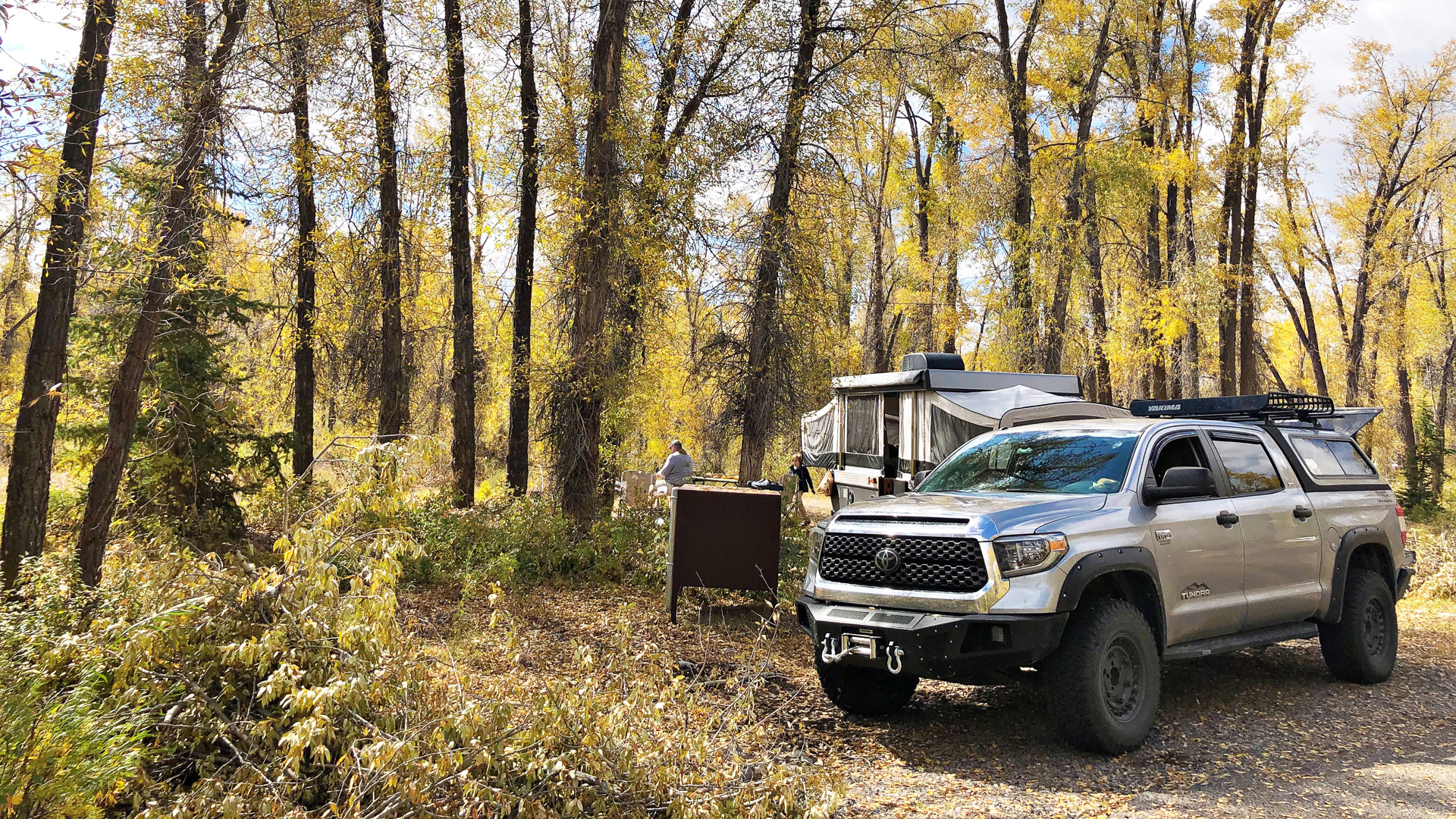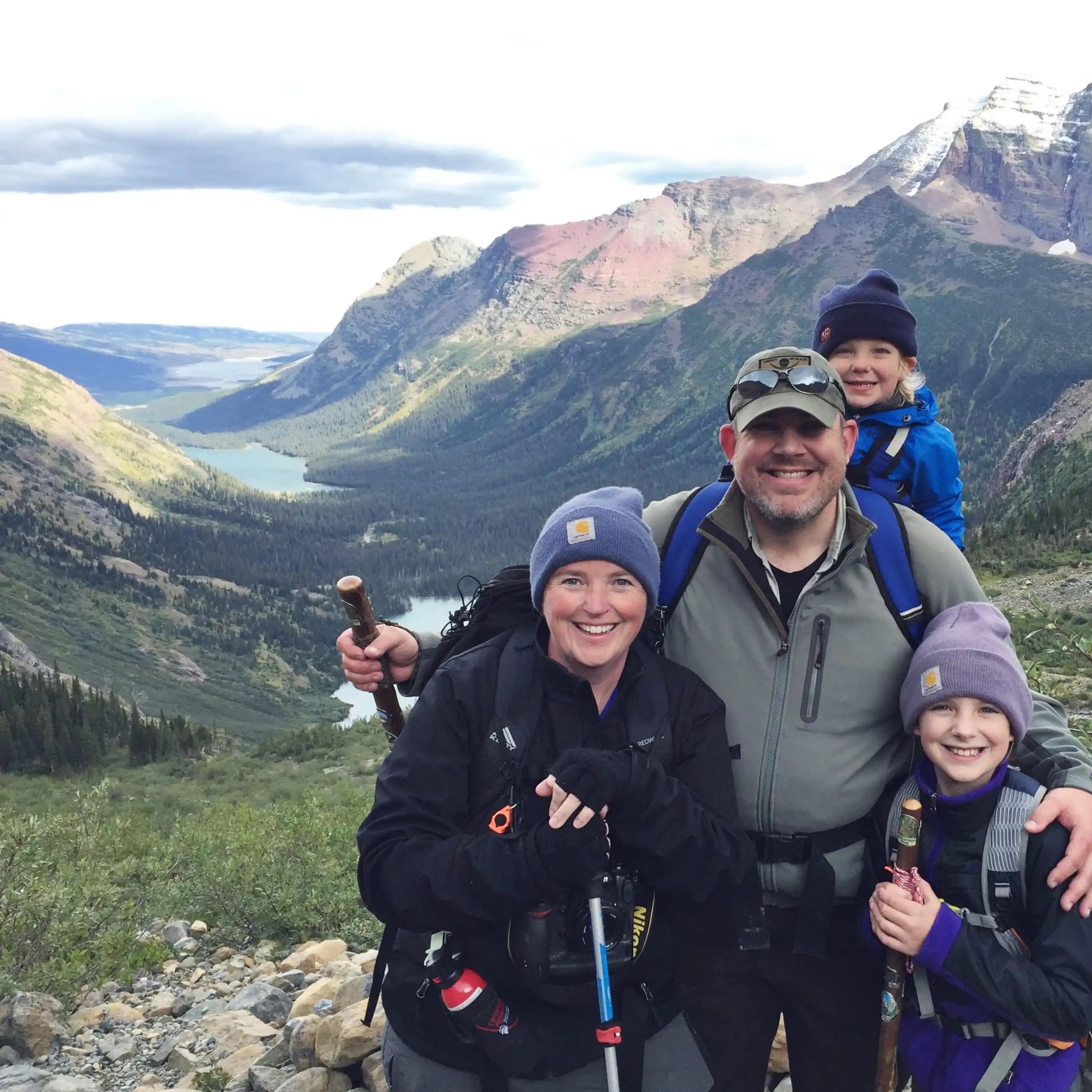
There are several ways to hit the road and go camp. Pop-up camping just might be the way to go for you. Learn how to get started in these seven steps.

Why a pop-up
A pop-up camper is a fantastic choice for family camping. Also sometimes called a tent trailer, both names accurately reflect its concept and design. A pop-up is towed with the tenting cranked down and closed into a hard-sided trailer from 8 to 14 feet in box length.
Upon arriving at your destination, the camper is “popped up” with a crank (either manual or electric) and the beds on either end are extended. The set-up length of the camper is twice the length of its hard-sided box. These features result in a camper that is lightweight, short and easy to see over — all of which make it great to tow. Pop-ups are also much easier to store than many other camper choices and are often far less expensive.
A pop-up represents the perfect blend of an RV and a tent: The tenting allows you to experience nature, while the trailer keeps you off the ground and provides some good storage for clothes, bedding and other gear. There is no better sound in the world than the sound of rain at night in a pop-up camper; the metallic sound of rain on the roof combined with the softer sound of it on the tenting is absolutely delightful. We also just enjoy the look of a pop-up camper — they have an iconic shape that has represented camping for generations.
My family owned a 1981 Coleman pop-up for a large part of my childhood, and I have amazing memories of crossing the country while sharing the tiny back seat of a Datsun truck with my brother. The Great American Road Trip is a strong legacy in our family, and I am so glad we get to raise our children the same way.

Which one to buy
The first step when buying any trailer is to verify the towing capacity of your vehicle. Many people are able to travel in small SUVs and minivans when towing a pop-up, which is part of what makes it such a versatile choice of camper. Remember to allow for the weight of passengers and cargo and follow all of the towing requirements in your owner’s manual.
When searching the market for a pop-up to buy, get the smallest and simplest model that will physically fit your family. The larger and more elaborate pop-ups can eliminate some of the benefits of having a pop-up by being heavier, more complicated to set up, more expensive and larger to store. Less really is more when you camp!
When inspecting one to buy, have the owner or dealer walk through the set-up and set-down procedure with you to see that it all goes smoothly. You also want to carefully inspect the tenting for any tears or mildew. Most modern pop-up tenting is a combination of both heavy-duty vinyl and canvas and, if cared for properly, will last a very long time. It is also advisable to crawl under the trailer and look for any damage. Check the condition of the tires and find out how long it has been since the axle bearings have been greased.
Also connect the camper to shore power and make sure all systems are functioning properly. Last but not least, verify the electric connection works when attached to the tow vehicle by checking that all lights and turn signals are functioning properly.

Learn how to use a pop-up
Pop-ups are very simple to use. Begin by reading the manual and getting all of your questions answered. You will want to practice setting it up before you take it anywhere and also practice backing it with the tow vehicle. A large, empty parking lot is ideal for learning how to reverse the trailer successfully into a parking spot, which will be helpful when backing into your first campsite. The basic set-up tools you will need include the crank, a level, leveling blocks and chocks.
Every pop-up is different, and that kit will expand as you learn what you need to set it up efficiently and correctly. The first few times you make camp, it will likely feel awkward, long and hard. All it takes to be proficient is practice and teamwork. As you keep taking it places regularly, your family will fall into routines and roles that begin to feel automatic and professional. Before you know it, setting up will be easy and fast. Maintenance on a pop-up is simple, especially since they have very few systems. Your manual will lay out what needs to be done and how often.
Thankfully, repairs on a pop-up also tend to be simple and cost-effective, and many are quite accessible for the average do-it-yourself person. There are many resources online to help diagnose and repair any issues you might have.

Keep it simple
After years of tent camping, we bought a 2005 Fleetwood Taos, a small, 8-foot pop-up, in 2014. As a family of four, we towed it tens of thousands of miles with a 2006 Honda Pilot — back and forth across the country numerous times and around our region countless times. After our Pilot crossed the 300,000-mile threshold, we bought a 2018 Toyota Tundra and continued to tow the same pop-up until 2020, when we had a chance to buy a 2017 Somserset E3 off-road pop-up with a 12-foot box.
We loved our time in our little pop-up and ultimately spent 364 nights in it before passing it along to a young couple we know — and they, too, are using it well. The big one is more comfortable for a family of four, and there are new conveniences. We have a cassette toilet inside and don’t need to go outside at night to make trips to the bathroom, which has been a great upgrade. Despite having a sink in the E3, we still do not connect to campground water, even when it’s available, simply because we are accustomed to dry camping.
We are thankful we started small and simple so that we were able to learn and grow and then make a wise decision for what our next camper would be. Our set-up procedure is still very simple and towing the larger pop-up is still very easy, but we have experience to thank for that reality. There is just no teacher-like experience, and we think every family can find what is right for them. Start small and keep it simple.

Successful systems
From the very beginning, we knew we would be spending a good bit of time in bear country, so we started out following bear protocol when we designed our packing systems. We store all food and outdoor kitchen gear in our tow vehicle. We never cook inside the pop-up and also rarely eat in it.
We set up an outdoor kitchen, exactly as we did while tent camping, and own an off-road, highly efficient refrigerator that stays in the back of the tow vehicle. At camp and awake, we usually have the back of the vehicle open, and it serves as an extension of the camper. Inside the pop-up, we store our sleeping bags and pillows.
Using sleeping bags keeps our bed-making process simple and easy — and it’s also a cozy camp atmosphere. We keep all of our clothing inside the camper; each person has a plastic storage box in which to keep their items.
One of the most important things to do when you first get a new camper is to set it up at home and spend some time organizing it and making it your own. You might need to add shelves to awkwardly sized cabinets or use plastic boxes or trays to separate things. It’s good to get a basic start and then modify as you go along. For short trips, I am able to pack without raising the roof by putting things from the house into our tow vehicle and transferring them to the pop-up when we make camp.
For a long trip, I will set up the camper and pack it from the inside out, staging the tow vehicle cargo area exactly how I need it to stay organized. I use large storage boxes in the back of the tow vehicle to organize and separate items. One of the nicest benefits to this basic system is that all of our food, water and outerwear is in the vehicle we use to go exploring. This makes unplanned picnics simple and also provides peace of mind when we drive off-road trails.

Versatility
Pop-ups are usable in all seasons and in all environments. We have camped with and without power hookups, and with and without a generator. We have camped in developed campgrounds of all types and sizes, truck stops, backyards and in the middle of nowhere. We have camped without power at -10°F and in sticky Southern summer humidity with a broken air conditioner. All the windows can be unzipped to create a cooling effect at night in even the hottest of conditions, and a propane heater can take the edge off the coldest conditions. A small generator can run the whole camper, but with LED light bulbs and few systems, it’s simple to camp without any power or water at all.
The tongue of a pop-up can carry the same propane bottles and battery as a much larger travel trailer or motorhome. As you book campsites, it’s easier to find sites that will accommodate the size of your rig in any type of campground. Many of the national park, national forest and state park campgrounds were built before RVs increased in size, so those campgrounds can provide challenges for people in larger rigs.
The campsites are too short, the turns are too sharp and a lack of hookups can be an issue. There are also many scenic roads across the country that are length and/or weight restricted, and you are less likely to be forced to skip these breathtaking byways when you are towing a pop-up.

It feels like camping
Pop-up camping encourages a degree of mental toughness that we desire in ourselves and in our children. We all work together to set up and do camp chores. The lack of amenities inside the camper encourages time in the outdoors to actually be time in the outdoors — the best seats are the ones by the campfire. We have found over the years that the simple nature of our camping setup is helping our children grow up without a sense of entitlement.
For an average of 70 nights a year, they get the experience of not having immediate access to running water or indoor plumbing. We think that perspective is extremely healthy in today’s world, and it just feels like camping. We love how the small space connects us to each other and how the tenting connects us to nature. We have slept in Yellowstone National Park to the sounds of the Madison River, bugling elk and howling wolves. We slept in Acadia National Park to the sounds of wind in the pines, a ringing buoy and the crashing surf. These are the soundscapes of our national parks and can be easily missed in a hard-sided camper.
A pop-up allows you to experience nature in a real and raw way — and we are all better for it. People often ask us when we are going to get something else, as if we need to upgrade, but we tell them we are just pop-up people.





